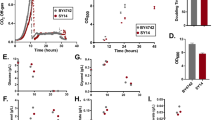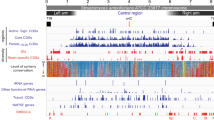Summary
Transcriptional analysis of the region flanking the left boundary of the centromere of chromosome VI revealed the presence of a gene immediately adjacent to CEN6. The transcription of the gene is directed toward the centromere, and nucleotide sequence analysis showed that the coding region terminates only 50 bp away from CEN6. Our results extend to chromosome VI the observation that centromere-flanking regions of S. cerevisiae are transcriptionally active. Disruption of the coding region of the gene showed that its product, whilst not essential for cell viability, is important for normal cell growth. The gene has been termed DEG1 (DEpressed Growth rate). Comparison of the deduced amino acid sequence of DEG1 with a protein sequence databank revealed homology with the enzyme tRNA pseudouridine synthase I of E. coli.
Similar content being viewed by others
References
Argos P (1987) J Mol Biol 193:385–396
Arps PJ, Marvel CC, Rubin BC, Tolan DA, Penhoet EE, Winkler ME (1985) Nucleic Acids Res 13:5297–5315
Barker DG, White JHM, Johnston LH (1985) Nucleic Acids Res 13:8323–8337
Bennetzen JL, Hall BD (1982) J Biol Chem 257:3026–3031
Bloom KS, Carbon J (1982) Cell 29:305–317
Butler JS, Platt T (1988) Science 242:1270–1274
Chlebowicz-Sledziewska E, Sledziewski AZ (1985) Gene 39:25–31
Dihanich ME, Najarian D, Clark R, Gillman EC, Martin NC, Hopper AK (1987) Mol Cell Biol 7:177–184
Ellis SR, Hopper AK, Martin NC (1987) Proc Natl Acad Sci USA 84:5172–5176
Favaloro J, Treisman R, Kamen R (1980) Methods Enyzmol 65:718–749
Fitzgerald-Hayes M (1987) Yeast 3:187–200
Hamilton R, Watanabe CK, de Boer HA (1987) Nucleic Acids Res 15:3581–3593
Henikoff S (1984) Gene 8:351–359
Henikoff S, Cohen EH (1984) Mol Cell Biol 4:1515–1520
Hieter P, Pridmore D, Hegemann J, Thomas M, Davis R, Philippsen P (1985) Cell 42:913–921
Hill A, Bloom K (1987) Mol Cell Biol 7:2397–2405
Hinnebusch AG, Fink GR (1983) J Biol Chem 258:5238–5247
Hopper AK, Furukawa AH (1982) Cell 28:543–550
Ito H, Fukuda Y, Murata N, Kimura A (1983) J Bacteriol 153:163–168
Langford CJ, Klinz FJ, Donath C, Gallwitz D (1984) Cell 36:645–653
Lo RYC, Bell JB, Roy KL (1982) Nucleic Acids Res 10:889–902
Magni GE, von Borstel RC (1962) Genetics 47:1097–1108
Maniatis T, Fritsch EF, Sambrook J (1982) In: Molecular cloning: a laboratory manual. Cold Spring Harbor Laboratory, Cold Spring Harbor, New York
Mann C, Davis RW (1986) Mol Cell Biol 6:241–245
Marczynski GT, Jaehning JA (1985) Nucleic Acids Res 13:8487–8506
Marvel CC, Arps PJ, Rubin BC, Kammen HO, Penhoet EE, Winkler ME (1985) J Bacteriol 161:60–71
Mortimer RK, Hawthorne DC (1966) Genetics 53:165–173
Mullenbach GT, Kammen HO, Penhoet EE (1976) J Biol Chem 251:4570–4578
Murray JAH, Cesareni G (1986) EMBO J 5:3391–3399
Osborne BI, Guarente L (1989) Proc Natl Acad Sci USA 86:4097–4101
Panzeri L, Philippsen P (1982) EMBO J 1:1605–1611
Panzeri L, Groth-Clausen I, Sheperd J, Stotz A, Philippsen P (1984) Chromosomes Today 8:46–58
Panzeri L, Landonio L, Stotz A, Philippsen P (1985) EMBO J 4:1867–1874
Proudfoot NJ, Brownlee GG (1976) Nature 263:211–214
Rothstein RJ (1983) Methods Enzymol 101:202–211
Russo P, Sherman F (1989) Proc Natl Acad Sci USA 86:8348–8352
Sanger F, Nicklen S, Coulson AR (1977) Proc Natl Acad Sci USA 74:5463–5467
Saunders M, Fitzgerald-Hayes M, Bloom K (1988) Proc Natl Acad Sci USA 85:175–179
Sentenac A, Hall BD (1982) In: Strathern JN, Jones EW, Broach JR (eds) The Molecular Biology of the Yeast Saccharomyces, vol 2. Cold Spring Harbor Laboratory, Cold Spring Harbor, New York, pp 561–606
Sharp PM, Tuohy TMF, Mosurski KR (1986) Nucleic Acids Res 14:5125–5143
Snyder M, Sapolsky RJ, Davis RW (1988) Mol Cell Biol 8:2184–2194
Thill G, Kramer R, Turner K, Bostian KA (1983) Mol Cell Biol 3:570–579
Tschumper G, Carbon J (1980) Gene 10:157–166
Yeh E, Carbon J, Bloom K (1986) Mol Cell Biol 6:158–167
Zaret KS, Sherman F (1982) Cell 28:563–573
Author information
Authors and Affiliations
Additional information
Communicated by G. Simchen
Rights and permissions
About this article
Cite this article
Agostoni Carbone, M.L., Solinas, M., Sora, S. et al. A gene tightly linked to CEN6 is important for growth of Saccharomyces cerevisiae . Curr Genet 19, 1–8 (1991). https://doi.org/10.1007/BF00362080
Received:
Accepted:
Issue Date:
DOI: https://doi.org/10.1007/BF00362080




